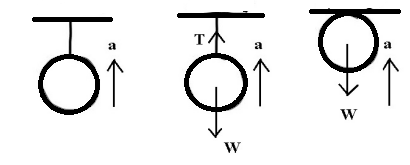
Concept explainers
Suppose the string in the figure in Question 48 breaks and the stone slows in its upward motion.
a. Draw a force vector diagram of the stone when it reaches the top of its path.
b. Is the net force on the stone zero at the top?
(a)
To draw: A force vector diagram of the stone when it reaches the top of its path.
Answer to Problem 49A
After reaching the top, no tension force will be applied to it. But, only gravity will act upon it.
The force vector diagram is shown in Figure 1.
Explanation of Solution
Introduction:
For a stable equilibrium, all the forces will balance each other.
As shown in the vector diagram below, both tension and force of gravity are acting upon the stone at starting. As the stone goes up with the external force, the tension in the force decreases, and the force of gravity which is constant supersedes. Once it is reached at the top, tension force disappears but only gravity applies.

Figure 1
Conclusion:
Thus, after reaching the top, no tension force will be applied to it. But, only gravity will act upon it. The force diagram is shown in Figure 1.
(b)
To identify: Whether the net force on the stone at the top is zero or not.
Answer to Problem 49A
After reaching the top, only the gravitational force will act upon the stone. Thus, the net force will not be zero.
Explanation of Solution
Introduction:
For a stable equilibrium, all the forces will balance each other.
Gravitational force on any object acts downwards and it is constant with for a mass. Tension in the force is acting upwards or towards the string. When it reaches the top of the string then the tension will not act upon the stone. Thus, only gravitational force will act downwards as shown in Figure 1. The net force is shown after reaching at the top in the third figure. The only force that acts upon the stone is gravitational force downwards. Thus, the net force will not be zero.
Conclusion:
After reaching the top, only gravitational force will act upon the stone. Thus, the net force will not be zero.
Chapter 3 Solutions
Conceptual Physics C2009 Guided Reading & Study Workbook Se
Additional Science Textbook Solutions
Chemistry: The Central Science (14th Edition)
Microbiology: An Introduction
Human Biology: Concepts and Current Issues (8th Edition)
Campbell Biology (11th Edition)
Physics for Scientists and Engineers: A Strategic Approach, Vol. 1 (Chs 1-21) (4th Edition)
Applications and Investigations in Earth Science (9th Edition)
- Figure 8.14 shows a cube at rest and a small object heading toward it. (a) Describe the directions (angle 1) at which the small object can emerge after colliding elastically with the cube. How does 1 depend on b, the so-called impact parameter? Ignore any effects that might be due to rotation after the collision, and assume that the cube is much more massive than the small object. (b) Answer the same questions if the small object instead collides with a massive sphere.arrow_forward2. A projectile is shot from a launcher at an angle 0,, with an initial velocity magnitude vo, from a point even with a tabletop. The projectile hits an apple atop a child's noggin (see Figure 1). The apple is a height y above the tabletop, and a horizontal distance x from the launcher. Set this up as a formal problem, and solve for x. That is, determine an expression for x in terms of only v₁, 0, y and g. Actually, this is quite a long expression. So, if you want, you can determine an expression for x in terms of v., 0., and time t, and determine another expression for timet (in terms of v., 0.,y and g) that you will solve and then substitute the value of t into the expression for x. Your final equation(s) will be called Equation 3 (and Equation 4).arrow_forwardDraw a phase portrait for an oscillating, damped spring.arrow_forward
- A person is running a temperature of 41.0°C. What is the equivalent temperature on the Fahrenheit scale? (Enter your answer to at least three significant figures.) °Farrow_forwardWhat is the period of a rock of mass 2.0kg tied to the end of a spring 0.625m long string that hangs in a doorway and has an elastic constant of 40N/m?arrow_forwardGive an example of friction speeding up an object.arrow_forward
- Which is the higher temperature? (Assume temperatures to be exact numbers.) (a) 272°C or 272°F? 272°C 272°F They are the same temperature. (b) 200°C or 368°F? 200°C 368°F They are the same temperature.arrow_forwardWhat is the direction of a force vector given by ~v = −6Nˆi − 8Nˆj?arrow_forwardWhat can be said of the position vector of an object far from any influences on its motion?arrow_forward
 College PhysicsPhysicsISBN:9781305952300Author:Raymond A. Serway, Chris VuillePublisher:Cengage Learning
College PhysicsPhysicsISBN:9781305952300Author:Raymond A. Serway, Chris VuillePublisher:Cengage Learning University Physics (14th Edition)PhysicsISBN:9780133969290Author:Hugh D. Young, Roger A. FreedmanPublisher:PEARSON
University Physics (14th Edition)PhysicsISBN:9780133969290Author:Hugh D. Young, Roger A. FreedmanPublisher:PEARSON Introduction To Quantum MechanicsPhysicsISBN:9781107189638Author:Griffiths, David J., Schroeter, Darrell F.Publisher:Cambridge University Press
Introduction To Quantum MechanicsPhysicsISBN:9781107189638Author:Griffiths, David J., Schroeter, Darrell F.Publisher:Cambridge University Press Physics for Scientists and EngineersPhysicsISBN:9781337553278Author:Raymond A. Serway, John W. JewettPublisher:Cengage Learning
Physics for Scientists and EngineersPhysicsISBN:9781337553278Author:Raymond A. Serway, John W. JewettPublisher:Cengage Learning Lecture- Tutorials for Introductory AstronomyPhysicsISBN:9780321820464Author:Edward E. Prather, Tim P. Slater, Jeff P. Adams, Gina BrissendenPublisher:Addison-Wesley
Lecture- Tutorials for Introductory AstronomyPhysicsISBN:9780321820464Author:Edward E. Prather, Tim P. Slater, Jeff P. Adams, Gina BrissendenPublisher:Addison-Wesley College Physics: A Strategic Approach (4th Editio...PhysicsISBN:9780134609034Author:Randall D. Knight (Professor Emeritus), Brian Jones, Stuart FieldPublisher:PEARSON
College Physics: A Strategic Approach (4th Editio...PhysicsISBN:9780134609034Author:Randall D. Knight (Professor Emeritus), Brian Jones, Stuart FieldPublisher:PEARSON





